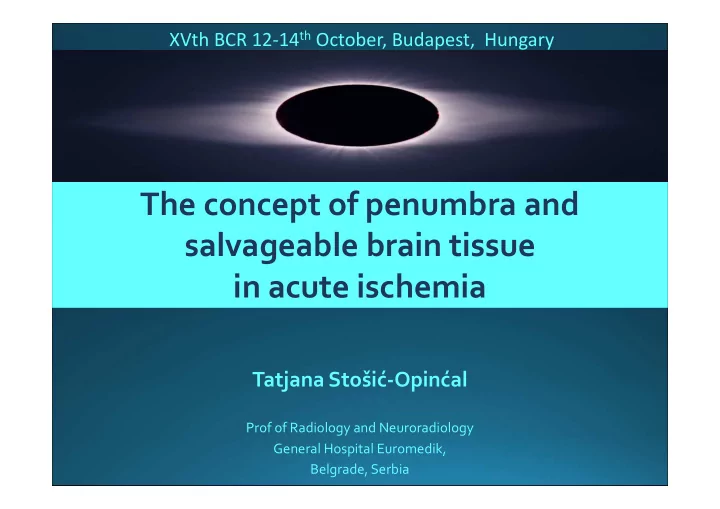

XVth BCR 12-14 th October, Budapest, Hungary The concept of penumbra and salvageable brain tissue in acute ischemia Tatjana Stošić-Opinćal Prof of Radiology and Neuroradiology General Hospital Euromedik, Belgrade, Serbia
CBF<10ml/100gr/min depletion of energy metabolites CELLS VESSELS Efflux of K+, Blood Brain barrier Infflux Na+, Ca++, damage water Cytotoxic edema Vasogenic edema (from the first (after first 6-8 hours) 3-5 minutes 30 seconds minutes)
Imaging of the penumbra � Modern imaging is able to identify the ischemic penumbra (CT, Lopez AD et al. Lancet 2006; 367:1747-1757 Rothwell PM et al. Lancet 2005; 366:1773-1783 O'Brien JT et al. Lancet Neurol 2003; 2:89-98
Radiographics, May-June2003.
At presentation After 3h After 24h Disappearing BG sign Insular ribbon sign 2 days later Dense artery sign - the most early sign, 35-67% of acute stroke (common in MCA); disappears within a few days or after thrombolysis. BE CAREFUL: false positive cases (calcified atherosclerosis and high hematocrit levels)
� Regions with reduced blood flow can be showed immediately after the occlusion � Penumbra - within the first 6 hours (sensitivity 100%) CBV CBF MTT OLIGEMIA Normal or Moderately Prolonged elevated reduced PENUMBRA Normal or Markedly Prolonged mildly reduced (> 145%) decreased INFARCT Severely Severely Strong prolongation CORE reduced reduced or not (<2 ml/100g) measurable CBV (ml/100g) CBF (ml/100g/min) MTT (sec) � Disadvantage: with every bolus injection only one segment could be evaluated
Threshold values for CTP CBV/MTT mismatch (penumbra) CBV<2ml/100gr = core infarct MTT>145% normal = penumbra Wintermark et al, 2008 Definite thresholds are not still available High correlation between CTP and MRP (Schaefer et al, 2008)
Folow up 90 min after IV-thrombolysis
Threshold values for CTP Image processing for voxel-based analysis � delay time ≥ 3 s and rCBF ≤ 30% - optimal thresholds for penumbra and core Yu, Y. et al . Defining Core and Penumbra in Ischemic Stroke: A Voxel- and Volume-Based Analysis of Whole Brain CT Perfusion. 2016.
CBF mismatch=CBF/CBV - - MTT CBV Courtesy B.Georgijevski-Brkic
F, 74 NIHSS 1=17 NIHSS 2= 9
F, 54 NIHSS 1=12 NIHSS 2=5
F, 55
F, 65
F, 72, wake up stroke
� *, SWI, � DWI/ADC � PWI (rCBV, rCBF, MTT) � MRA
Diffusion weighted imaging (DWI) � core � restricted diffusion �
DWI M 38 yrs with CT 1h, T2W i DWI 2h, weakness of left leg, arm and face CT 5 days after stroke
� Measurements of tissue perfusion provide reliable estimates of the penumbra � Shows hemodynamic status within the first minutes of acute stroke � Relative maps (MTT, CBV, CBF) show area of reduced perfusion in penumbra
� � • •
M, 72 ��� ��� ���
��� ��� ���
Detect Tissue at Risk with MRI – PD mismatch � � � � Mismatched tissue represents “tissue-at-risk” PWI > DWI PWI = DWI PWI < DWI MATCH Mismatch Repefusion (no tissue at (penumbra) risk) No No Thrombolysis thrombolysis thrombolysis
NORMAL: CBF in GM 50-60 ml/100gr/min OLIGEMIA: CBF < 35 ml/100gr/min (50-60% of normal values) PENUMBRA : CBF < 20 ml/100gr/min (30-40%) IRREVERSIBILE CELL DEATH: CBF <10 ml/100gr/min (20%) � PDM does not optimally define ischemic penumbra � Early DWI abnormality overestimates infarct core (include part of penumbra) � PWI abnormality overestimates penumbra (including benign oligemia) � The area of final infarction is normally smaller than the maximum perfusion deficit
Chen F, Ni YC. Magnetic resonance diffusion-perfusion mis-match in acute stroke. World J Radiol 2012; 4(3):63-74.
� classical type (49%-70%) - target mismatch or positive mismatch
� no target mismatch was the most common type in patients with diabetes
� inverse or negative mismatch or “hidden mismatch” (PWI < DWI) , small subcortical ischemic stroke
� � � single small artery occlusion or presence of small subclinical infarct �
� total mismatch migraine or TIA
Hypoperfusion affecting > 1 vascular territory Floery AJNR 33 Sep 2012.
migraine PET
� malignant mismatch � poor outcome brain hemorrhage Albers GW et al. Magnetic resonance imaging profiles predict clinical response to early reperfusion: The diffusion and perfusion imaging evaluation for understanding stroke evolution (DEFUSE) study. Ann Neurol. 2006;60:508–517. Davis SM, et al. Effects of alteplase beyond 3 h after stroke in the echoplanar imaging thrombolytic evaluation trial (EPITHET): A placebo-controlled randomised trial. Lancet Neurol. 2008;7:299–309.
M, 51 1h after onset of stroke, hemiplegia l.sin .
DWI – b 1000
ADC
CBF
MTT
� PDM is not yet perfectly matched with the ischemic penumbra � Although MR is currently preferred imaging method for determining core and penumbra, CT perfusion is comparable and potentially more available � Acute stroke patients with significant PD mismatch lesion volumes benefit from reperfusion therapies � Little or no PDM and very large ischemic lesions may not benefit or may be harmed ( hemorrhage or reperfusion injury ) following early reperfusion.
Thank You
Recommend
More recommend